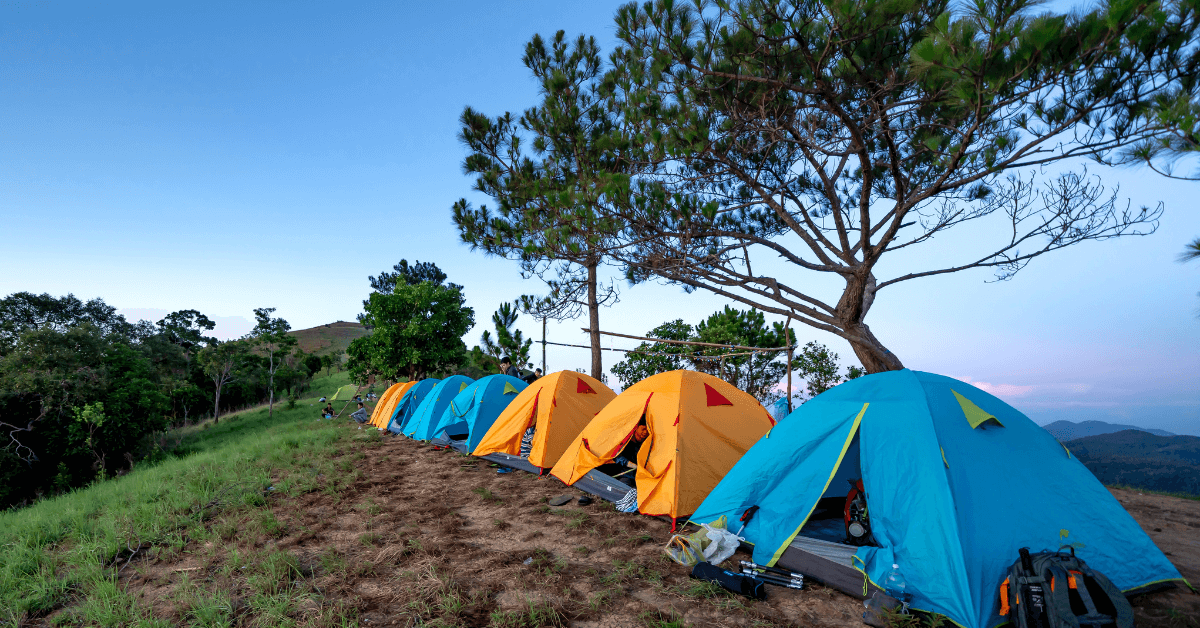Camping is an exciting adventure that allows you to connect with nature and escape the hustle and bustle of everyday life. However, finding the perfect spot to pitch your tent can be a challenge, especially if you’re considering camping on a hill.
Camping on a hill can be a great way to enjoy stunning views, improve ventilation, and ensure drier ground, but it also presents unique challenges that can make your camping trip less enjoyable if you’re not adequately prepared. Below, we’ll explore whether it’s possible to pitch a tent on a hill and provide helpful tips for camping on hills safely and comfortably.
We’ll also examine the pros and cons of hill camping, discuss the factors to consider before pitching a tent on a hill, and offer practical advice on how to anchor your tent securely to prevent it from rolling down the hill. By the end of the article, you’ll be equipped with the knowledge and skills you need to enjoy a memorable and safe camping experience on a hill.
Can You Pitch a Tent On a Hill?
Yes, you can pitch a tent on a hill, but it requires careful consideration and preparation. Camping on a hill offers several advantages, such as breathtaking views, privacy, and unique experiences. However, it also comes with potential risks and challenges, such as uneven terrain, strong winds, and rolling down the hill.
Before pitching a tent on a hill, you should consider several factors, such as the slope and terrain of the hill, weather conditions, potential hazards, and the type of gear and equipment you need. You should also follow Leave No Trace principles and respect the natural environment.
Let’s take a deeper dive.
Pros and Cons of Pitching a Tent on a Hill
Camping on a hill has its pros and cons, and it’s essential to weigh them carefully before setting up your tent. Here are some advantages and disadvantages to consider:
Pros:
- Better Views: One of the most significant advantages of camping on a hill is the stunning views you can enjoy. You’ll have an unobstructed view of the surrounding landscape, which can be breathtaking at sunrise and sunset.
- Improved Ventilation: Camping on a hill can also improve ventilation, as the breeze tends to be stronger at higher elevations. This can be especially helpful on hot summer days, as it will help keep you and your tent cool.
- Drier Ground: Hilltops are generally drier than valleys and low-lying areas, making them an excellent choice if you want to avoid damp ground. This can be particularly important if you’re camping in wet or rainy conditions.
- Privacy: Camping on a hill can also provide more privacy than camping in a crowded campsite or at the bottom of a valley. You’ll have fewer neighbors and more space to yourself, which can be a significant advantage for some campers.
Cons:
- Uneven Ground: One of the most significant disadvantages of camping on a hill is the uneven ground. It can be challenging to find a flat spot to pitch your tent, and you’ll likely need to do some digging and leveling to make it work.
- Potential for Rolling Down the Hill: Another significant disadvantage of hill camping is the potential for your tent to roll or slide down the hill. This can be dangerous and uncomfortable, and you’ll need to take precautions to ensure your tent is securely anchored to prevent this from happening.
- Challenging Terrain: Camping on a hill can be physically challenging, as you’ll need to hike up with all your gear and supplies. The terrain can also be steep and rugged, making it harder to find a suitable campsite.
- Exposure to Wind: Hilltops are often exposed to wind, which can be a disadvantage if you’re camping in windy conditions. You’ll need to make sure your tent is sturdy and well-anchored to avoid damage or collapse.
It’s essential to weigh the pros and cons carefully and make sure you’re adequately prepared with the right equipment, skills, and knowledge to ensure a safe and enjoyable camping experience.
Related: How Much Does It Cost To Run A Campground?
Factors to Consider Before Pitching a Tent on a Hill
Camping on a hill can be an enjoyable and unique experience, but it’s important to consider some essential factors before pitching your tent. Here are some critical factors to consider:
1. Terrain
The terrain is one of the most crucial factors to consider when choosing a hilltop campsite. Make sure the ground is stable, not too steep, and free of obstacles like rocks or fallen trees. It’s also important to avoid areas that are prone to landslides or other natural hazards.
2. Wind
Wind can be a significant factor to consider when camping on a hill. It’s essential to choose a sheltered spot and make sure your tent is securely anchored to avoid damage or collapse. You can also consider setting up a windbreak or tarp to protect your tent from strong winds.
3. Water
Access to water is essential when camping, so it’s essential to consider the availability of water sources when choosing a hilltop campsite. Make sure to bring enough water with you or plan to filter or purify water from nearby sources.
4. Sun Exposure
Hilltops can be exposed to intense sunlight, so it’s crucial to choose a spot that offers shade during the hottest parts of the day. You can also consider bringing a tarp or canopy to provide extra shade.
5. Wildlife

Hilltops can be home to a variety of wildlife, including bears, mountain lions, and snakes, so it’s important to take precautions to prevent encounters with these animals. Store food securely, avoid leaving garbage or food scraps around, and be aware of the signs of wildlife activity in the area.
6. Access
Access to the campsite is also an important factor to consider. Make sure you have a clear and safe route to your campsite and that you can easily transport your gear and supplies up the hill. You may also want to consider how far your campsite is from other amenities like bathrooms, showers, or stores.
By carefully considering these factors, you can choose a hilltop campsite that offers stunning views and a unique camping experience while ensuring your safety and comfort.
Tips for Pitching a Tent on a Hill
Pitching a tent on a hill requires careful preparation and the right gear. In this section, we’ll provide tips and insights to help you pitch a tent on a hill successfully. From choosing the right campsite to securing your tent, we’ll provide valuable information to make your camping trip safe and memorable.
1. Choose the right location
Before pitching your tent on a hill, make sure to find a flat and even spot. You can use a level or a small ball to check the ground’s angle to ensure that you are not sleeping at an uncomfortable angle. If possible, try to find a spot that’s sheltered from strong winds and has access to water.
2. Anchor your tent properly
When camping on a hill, it’s important to secure your tent firmly to the ground to prevent it from sliding down. Make sure to use sturdy stakes, guylines, and tensioners to anchor your tent. If the ground is too hard, you can use rocks or boulders to hold down the stakes.
3. Use a footprint
A footprint is a protective layer that goes beneath your tent to prevent water and other debris from seeping into your tent. It also helps to protect the bottom of your tent from getting punctured by sharp rocks or sticks. When camping on a hill, a footprint is especially important since the ground can be uneven and rocky.
4. Be prepared for wind and rain
Camping on a hill means that you’re more exposed to the elements, including wind and rain. Make sure to bring a rainfly to cover your tent and protect it from rain. You can also consider setting up a windbreak or tarp to protect your tent from strong winds.
5. Pack light
When camping on a hill, every extra pound can make the hike up the hill more difficult. So, it’s important to pack light and only bring essential gear and supplies. Consider using a backpacking tent instead of a larger family tent to save weight.
6. Stay organized
When camping on a hill, it’s easy for gear and supplies to roll down the slope or get misplaced. So, it’s essential to stay organized and keep your gear securely stored. Use a backpack or duffel bag to transport your gear and keep it organized inside your tent.
Alternative Camping Options on a Hill
If pitching a tent on a hill seems too challenging or risky, don’t worry. In this section, we’ll explore alternative camping options you can consider, such as hammock camping, tarp camping, bivy camping, and camper van or RV camping. We’ll also discuss mountain huts and shelters that offer a unique camping experience on a hill.
1. Hammock camping
Hammock camping has become increasingly popular in recent years as it offers a lightweight and comfortable alternative to traditional tent camping.
Hammocks can be easily set up on trees or poles, making them a great option for camping on a hill. They are also elevated off the ground, providing a unique perspective and stunning views.
2. Tarp camping
Tarp camping involves setting up a tarp or a lightweight shelter instead of a tent. It’s a great option for those who want to pack light and sleep under the stars. Tarps can be set up using poles or trees and offer a lot of flexibility in terms of size and shape.
3. Bivy camping
The realm of Bivy camping involves sleeping in a bivy sack, which is a waterproof and breathable bag designed to protect you from the elements while sleeping. Bivy sacks are lightweight and easy to pack, making them a great option for camping on a hill. They also offer a unique and intimate experience of sleeping out in nature.
4. Camper van or RV camping
If you have access to a camper van or an RV, camping on a hill becomes a lot easier and more comfortable. You can park your vehicle on a flat spot and enjoy the stunning views without having to worry about pitching a tent or setting up a shelter.
5. Mountain huts or shelters
In some areas, there are mountain huts or shelters that you can rent or use for free. These huts provide basic accommodations and shelter from the elements, making them a great option for camping on a hill. They also offer a chance to meet other hikers and outdoor enthusiasts.
Final Thoughts
Yes, you can pitch a tent on a hill, but it requires careful consideration of factors such as the slope and terrain of the hill, weather conditions, potential hazards, and the type of gear and equipment needed. It is important to plan ahead, be prepared, and respect the natural environment to ensure a safe and enjoyable camping experience.
Make sure to choose a location that is safe and stable for camping. Consider the weather conditions and potential hazards, such as strong winds or falling rocks. And always bring the right gear and equipment, such as tent stakes and guy lines, to secure your tent and ensure your safety.
If pitching a tent on a hill seems too challenging or risky, don’t worry. There are several alternative camping options, such as hammock camping, tarp camping, bivy camping, camper van or RV camping, and mountain huts or shelters, that you can consider.
